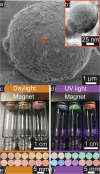Enabling the Polymer Circular Economy: Innovations in Photoluminescent Labeling of Plastic Waste for Enhanced Sorting
- PMID: 37065718
- PMCID: PMC10103190
- DOI: 10.1021/acspolymersau.2c00040
Enabling the Polymer Circular Economy: Innovations in Photoluminescent Labeling of Plastic Waste for Enhanced Sorting
Abstract
It is widely accepted that moving from a linear to circular economy for plastics will be beneficial to reduce plastic pollution in our environment and to prevent loss of material value. However, challenges within the sorting of plastic waste often lead to contaminated waste streams that can devalue recyclates and hinder reprocessing. Therefore, the improvement of the sorting of plastic waste can lead to dramatic improvements in recyclate quality and enable circularity for plastics. Here, we discuss current sorting methods for plastic waste and review labeling techniques to enable enhanced sorting of plastic recyclates. Photoluminescent-based labeling is discussed in detail, including UV-vis organic and inorganic photoluminescent markers, infrared up-conversion, and X-ray fluorescent markers. Methods of incorporating labels within packaging, such as extrusion, surface coatings, and incorporation within external labels are also discussed. Additionally, we highlight some practical models for implementing some of the sorting techniques and provide an outlook for this growing field of research.
© 2022 The Authors. Published by American Chemical Society.
Conflict of interest statement
The authors declare no competing financial interest.
Figures

















Similar articles
-
Mechanical Recycling of Packaging Plastics: A Review.Macromol Rapid Commun. 2021 Feb;42(3):e2000415. doi: 10.1002/marc.202000415. Epub 2020 Sep 30. Macromol Rapid Commun. 2021. PMID: 33000883 Review.
-
Polyolefin Recyclates for Rigid Packaging Applications: The Influence of Input Stream Composition on Recyclate Quality.Polymers (Basel). 2023 Jun 22;15(13):2776. doi: 10.3390/polym15132776. Polymers (Basel). 2023. PMID: 37447422 Free PMC article.
-
Polydiketoenamines for a Circular Plastics Economy.Acc Chem Res. 2022 Oct 4;55(19):2753-2765. doi: 10.1021/acs.accounts.2c00308. Epub 2022 Sep 15. Acc Chem Res. 2022. PMID: 36108255
-
Evaluation of Marker Materials and Spectroscopic Methods for Tracer-Based Sorting of Plastic Wastes.Polymers (Basel). 2022 Jul 29;14(15):3074. doi: 10.3390/polym14153074. Polymers (Basel). 2022. PMID: 35956603 Free PMC article.
-
Black plastics: Linear and circular economies, hazardous additives and marine pollution.Environ Int. 2018 Aug;117:308-318. doi: 10.1016/j.envint.2018.04.036. Epub 2018 May 17. Environ Int. 2018. PMID: 29778831 Review.
Cited by
-
Review and Assessment of Existing and Future Techniques for Traceability with Particular Focus on Applicability to ABS Plastics.Polymers (Basel). 2024 May 9;16(10):1343. doi: 10.3390/polym16101343. Polymers (Basel). 2024. PMID: 38794535 Free PMC article. Review.
-
Waste Study on Flexible Food and Non-Food Packaging: Detailed Analysis of the Plastic Composition of European Polyethylene-Containing Waste Streams.Materials (Basel). 2024 Jun 30;17(13):3202. doi: 10.3390/ma17133202. Materials (Basel). 2024. PMID: 38998285 Free PMC article.
-
An Advanced CNN-Based Framework for the Automated Detection of Uncovered PET in Recycling Streams.Polymers (Basel). 2025 Jun 22;17(13):1736. doi: 10.3390/polym17131736. Polymers (Basel). 2025. PMID: 40647747 Free PMC article.
-
Industrial and Laboratory Technologies for the Chemical Recycling of Plastic Waste.ACS Catal. 2024 Aug 5;14(16):12437-12453. doi: 10.1021/acscatal.4c03194. eCollection 2024 Aug 16. ACS Catal. 2024. PMID: 39169909 Free PMC article. Review.
-
Polymer up-cycling by mangana-electrocatalytic C(sp3)-H azidation without directing groups.Chem Sci. 2023 Jul 5;14(30):8109-8118. doi: 10.1039/d3sc02549g. eCollection 2023 Aug 2. Chem Sci. 2023. PMID: 37538824 Free PMC article.
References
-
- US EPA . Plastics: Material-Specific Data. https://www.epa.gov/facts-and-figures-about-materials-waste-and-recyclin... (accessed Aug 2, 2022).
-
- Plastics Europe . Plastics - the Facts 2021. 2021. https://plasticseurope.org/knowledge-hub/plastics-the-facts-2021/ (accessed July, 2022).
-
- Van Beukering P. J. H.; Van Den Bergh J. C. J. M. Modelling and Analysis of International Recycling between Developed and Developing Countries. Resour. Conserv. Recycl. 2006, 46 (1), 1–26. 10.1016/j.resconrec.2005.06.002. - DOI
Publication types
LinkOut - more resources
Full Text Sources
